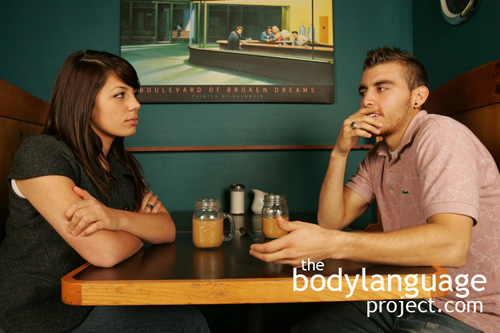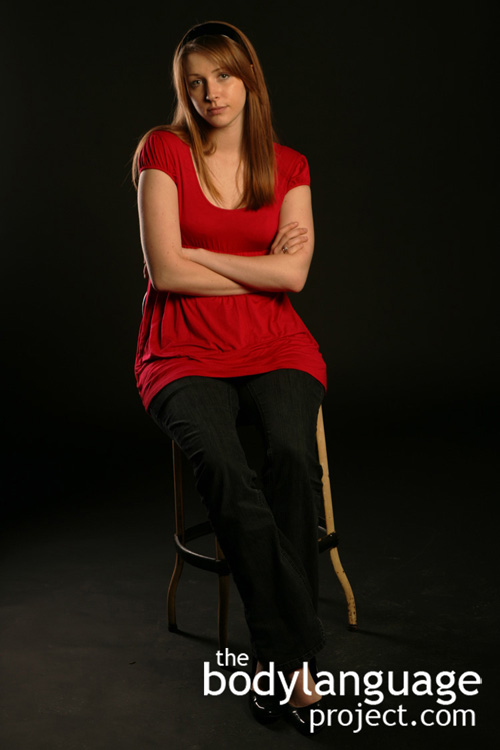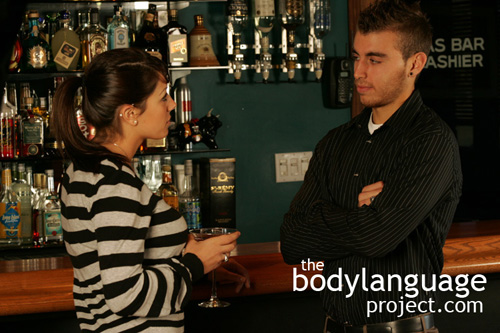Body Language of Stiff Arm and Thrust Forward Handshake
 Cue: Stiff Arm and Thrust Forward Handshake
Cue: Stiff Arm and Thrust Forward Handshake
Synonym(s): N/A
Description: The stiff arm thrust forward happens when someone grabs your hand then pushes you backwards putting you off balance.
In One Sentence: The stiff arm thrust forward handshake is usually done by a person who wants to maintain their personal space and is not afraid to say so.
How To Use it: Use the stiff arm thrust forward handshake when you want to keep a person out of your personal space. The signal will help you express your desire for more space and to show them not to encroach on you. This sort of handshake is mostly suited to those who desire more than average level of personal space such as those living in the country.
Context: General.
Verbal Translation: “I need more space than you do and I’m not afraid to move you out of my personal space bubble by pushing you away.”
Variant: See Country Handshake (The), Cold Dead Wet Fish Handshake, Double Gripper Politician Handshake or Double Hander (The), Short Grabber/Finger Grabber Handshake, Oddball Handshake, Palm Up, Palm Down and Palm Even Handshakes, Stiff Arm And Thrust Forward Handshake, Death Grip Handshake, Wrench Forward Handshake, Undershaker Handshake, Wrist Hold Handshake, Wrist Hold Handshake and Upper Arm Grip Handshake, Limp Fish Handshake, Teacup Handshake, Arm Twister Handshake (The), Firm handshake, Fist Bumping.
Cue In Action: It was rare for the two salesman to be in the same office together as it was the busy season and both were aggressively campaigning to grow into new sectors. When they shook hands it was clear that one of them didn’t condone the others aggressive tactics. He made a point of going over and saying his peace. When he shook hands – he squeezed firmly and pushed him back and away, making it clear that he was overstepping his boundaries.
Meaning and/or Motivation: It’s a common occurrence for those trying to maintain their distance. Take for example a “city slicker” and a “country farmer” who meet for the first time. The farmer might accept the handshake even though a wave would be more appropriate for their comfort and to keep his space will push his arm forward shoving the city slicker back.
This sort of handshake can happen anytime a person requires more space than their partner and this isn’t always people from the country.
Cue Cluster: Expect the stiff arm handshake to be coupled with authoritative or aggressive body language such as arms akimbo or the cowboy stance, expressionless or stern facial expressions, moving to quieter locations out of the way and a reserved demeanor unless provoked.
Body Language Category: Aggressive body language, Authoritative body language, Defensive , Dislike (nonverbal), Distancing or moving away, Dominant body language, Escape movements, Guiding body language, Hostile body language, Power play, Space invasion, Stubborn or stubbornness, Social touching, Threat displays.
Resources:
Aranguren, Martin. “Nonverbal interaction patterns in the Delhi Metro: interrogative looks and play-faces in the management of interpersonal distance.” Interaction Studies. 2016. 16(1) forthcoming.
Aranguren, Martin and Stephane Tonnelat. Emotional Transactions in the Paris Subway: Combining Naturalistic Videotaping, Objective Facial Coding and Sequential Analysis in the Study of Nonverbal Emotional Behavior. Journal of Nonverbal Behavior. 2014. 38:495–521. DOI 10.1007/s10919-014-0193-1
http://bodylanguageproject.com/articles/seriously-stop-touching-use-nonverbal-signaling-manage-unwanted-touching-busy-public
Aström, J ; Thorell, L H ; Holmlund, U ; D’Elia, G. Handshaking, personality, and psychopathology in psychiatric patients, a reliability and correlational study. Perceptual and motor skills 1993, Vol.77(3 Pt 2): 1171-86.
Beaulieu, Catherine. Intercultural Study of Personal Space: A Case Study. Journal of Applied Social Psychology. 2004 34(4):794-805.
Chaplin William F.; Phillips Jeffrey B; Brown Jonathan D.; Clanton Nancy R.; Stein Jennifer L.; 2000. Handshaking, gender, personality, and first impressions Journal of personality and social psychology. 79(1): 110-117.
Dolcos, Sanda ; Sung, Keen ; Argo, Jennifer J ; Flor-Henry, Sophie ; Dolcos, Florin. The power of a handshake: neural correlates of evaluative judgments in observed social interactions. Journal of cognitive neuroscience. 2012 24(12): 2292-305.
Dolphin, Carol Zinner. Beyond hall: Variables in the use of personal space in intercultural transactions. Howard Journal of Communications. 1988. 1(1): 23-38.
Fisher, J; Rytting, M and Heslin, R. 1976. Hands touching hands: affective and evaluative effects on interpersonal touch, Sociometry 39: 416–421.
Frumin, Idan; Ofer Perl; Yaara Endevelt-Shapira; Ami Eisen; Neetai Eshel; Iris Heller; Maya Shemesh; Aharon Ravia; Lee Sela; Anat Arzi and Noam Sobel. A Social Chemosignaling Function for Human Handshaking. eLife 2015. 4:e05154
DOI: http://dx.doi.org/10.7554/eLife.05154.
http://bodylanguageproject.com/articles/shake-hands-share-human-scent-curious-case-hand-sniffing-body-language/
Greenbaum, Paul ; Rosenfeld, Howard. Varieties of touching in greetings: Sequential structure and sex-related differences. Journal of Nonverbal Behavior. 1980. 5(1): 13-25.
Gueguen, Nicolas. Handshaking and Compliance With a Request – A Door-to-door Setting. Social Behavior and Personality. 2013. 41(10): 1585-1588.
http://bodylanguageproject.com/articles/handshakes-lead-compliance-study/
Greenberg, Carl I. ; Firestone, Ira J. Greenwald, Anthony G. (editor). Compensatory responses to crowding: Effects of personal space intrusion and privacy reduction. Journal of Personality and Social Psychology. 1977. 35(9): 637-644.
Graziano, Michael S.A. and Cooke, Dylan F. Parieto-frontal interactions, personal space, and defensive behavior. Neuropsychologia. 2006. 44(6): 845-859.
Holt, Daphne J ; Cassidy, Brittany S ; Yue, Xiaomin ; Rauch, Scott L ; Boeke, Emily A ; Nasr, Shahin ; Tootell, Roger B H ; Coombs, Garth. Neural correlates of personal space intrusion. The Journal of neuroscience : the official journal of the Society for Neuroscience. 2014. 34(12): 4123-34.
Hiemstra, Kathleen M. Shake My Hand: Making the Right First Impression in Business With Nonverbal Communications.(Brief Article)(Statistical Data Included). Business Communication Quarterly. 1999. 62(4): 71.
Jeffrey D. Fisher; Marvin Rytting; Richard Heslin. 1976. Hands Touching Hands: Affective and Evaluative Effects of an Interpersonal Touch. Sociometry, 39(4): 416-421.
Lipsitz, Rebecca (2000). “A Gripping Start.” In Scientific American (September), p. 32.
Morris, Desmond (1994). Bodytalk: The Meaning of Human Gestures (New York: Crown Publishers).
Mcelroy, James C. ; Morrow, Paula C. Personal space, personal appearance, and personal selling. Psychological Reports. 1994 74(2): 425(2).
Mcgurk, Barry J. ; Davis, John D. ; Grehan, John. Assaultive behavior personality and personal space. Aggressive Behavior. 1981. 7(4): 317-324.
Newman, Robert C. ; Pollack, Donald Holzberg, Jules D. (editor). Proxemics in deviant adolescents. Journal of Consulting and Clinical Psychology. 1973 40(1): 6-8.
Okken, Vanessa ; Van Rompay, Thomas ; Pruyn, Ad. Room to Move: On Spatial Constraints and Self-Disclosure During Intimate Conversations. Environment and Behavior. 2013. 45(6): 737-760.
Pease, Barbara and Allan Pease. 2006. The Definitive Book of Body Language Hardcover. Bantam.
Sanda Dolcos; Keen Sung; Jennifer J. Argo; Sophie Flor-Henry and Florin Dolcos. The Power of a Handshake: Neural Correlates of Evaluative Judgments in Observed Social Interactions. Journal of Cognitive Neuroscience. 24; 12: 2292–2305.
http://bodylanguageproject.com/articles/handshake-open-body-language-powerful-nonverbal-effect-brain/
Stewart, Greg L. ; Dustin, Susan L. ; Barrick, Murray R. ; Darnold, Todd C. Zedeck, Sheldon (editor). Exploring the Handshake in Employment Interviews. Journal of Applied Psychology. 2008. 93(5): 1139-1146.
Spezialetti, Brian D. Do’s and don’ts for winning the job interview. (laboratory technicians). Medical Laboratory Observer. 1995. 27(7): 51-53.
Wesson, David A. The handshake as non-verbal communication in business. (marketing technique). Marketing Intelligence & Planning. 1992. 10(9): 61(6).
Werner, Carol ; Brown, Barbara ; Damron, Gary Steiner, Ivan D. (editor). Territorial marking in a game arcade. Journal of Personality and Social Psychology. 1981. 41(6): 1094-1104.





